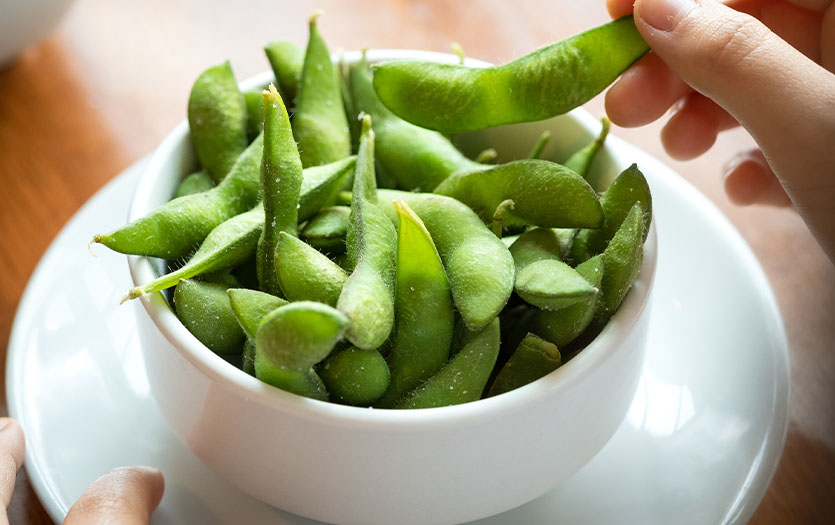
This post was written based on a Powered by Plants presentation hosted by Kristin Gerhardstein, MD, PPG – Family Medicine and Primary Care, and Kathy Wehrle, RDN, community outreach dietitian, Parkview Health.
Soy is a nutrient-dense plant, a powerful protein source and a great food to include in a whole food, plant-based (WFPB) eating approach. Despite controversy in prior years, recent studies suggest soy has either a beneficial or neutral effect on various health conditions. Here, we’ll delve into the best sources, what the research is saying and a pair of recipes that will tempt you to give it a try!
If you’re interested in shifting to a plant-forward diet, check out this ten-week breakdown.
What is soy?
Soybeans are a nutrient-dense plant protein that lives in the legume family. Soy contains all of the essential amino acids our body needs, comparable to animal protein sources, as well as plant fats, fiber, polyphenols, and several vitamins and minerals. It also has the highest biological value of protein of any legume.
Sources of soy
Various forms of soy foods are on the market, with edamame being the least processed. This list can serve as a helpful guide for securing soy on your next shopping trip:
- Edamame (in shell) or mukimame (no shell)
- Tofu
- Tempeh
- Soy nuts
- Soy curls
- Soy milk
- Miso
- Soy sauce/tamari
- Textured soy protein
- Meat alternatives
A few words on tamari vs. soy sauce. People often talk about these two products interchangeably, but some key differences exist. Tamari’s flavor is richer, savory and more nuanced. It has a thicker consistency, fewer ingredients, and is both vegan and gluten-free. Soy sauce, on the other hand, has a saltier, sharp, vinegar-like flavor. It contains wheat and preservatives.
It's important to choose soy in its least processed forms:
- Whole soybeans – edamame
- Minimally processed – tofu
- Minimally processed – tempeh
- Minimally processed – soy milk
Pass on soy protein isolates and, if possible, purchase organic soy. About 93% of soy is GMO (much is “Round-up ready” soybeans, sprayed with glyphosate, a pesticide).
Avoid soy if you are allergic (1 in 2,000 folks report a soy allergy).
A soy deep dive
In the Harvard School of Public Health article “Straight Talk about Soy,” authors share that studies may seem to present conflicting conclusions about soy, but this is largely due to the wide variation in how soy is studied.
The article examines isoflavones (plant estrogens/phytoestrogens) in greater detail and outlines their weaker effects compared to human estrogen.
As a key takeaway, authors find soy to be a nutrient-dense protein source, rich in micronutrients like B vitamins, magnesium and potassium.
Soy and common chronic conditions
Heart disease
- An epidemiological study in men and women with no cardiovascular disease found that those eating the highest amount of tofu/isoflavones from soy had an 18% and 13% lower risk of developing heart disease.
- Replacing red meat with plant proteins, including soy, was associated with a 14% lower risk of heart disease.
- In 500,000 Chinese adults with no previous cardiovascular disease, those with the highest intake of soy (4+ days/week) compared with those who never ate soy had a 25% lower risk of death from a heart attack.
Hot flashes and other menopause symptoms
- In Asian countries, women report lower rates of menopausal symptoms. In the U.S., 70-80% of women report symptoms compared to 10-20% in Far Eastern Asian women).
- Some trials and clinical studies show small and gradual effects of a soy-inclusive diet weakening hot flashes, but the presence of “equo” (a protective substance made by the breakdown of isoflavones, which only some women produce) may be needed to effectively reduce hot flashes. Further research is needed.
Prostate cancer
- Prostate cancer is highest in Western countries and lowest in Asian countries. When Chinese and Japanese men move and eat the Western diet, their instances of prostate cancer go up.
- In a meta-analysis of 30 studies (U.S., Europe, Japan, China), intakes of soy foods were associated with a lower risk of prostate cancer.
Memory and cognitive function
- Fermented soy foods may have benefits for neurological disorders as seen in animal studies. Human studies are not conclusive at this time.
Bone health
On the podcast Nutrition Facts with Dr. Greger's episode “The Benefits of Soy,” he shared that:
- Population data suggests the consumption of soy is associated with increased bone mass.
- A significantly lower risk of bone fracture was associated with just a single serving of soy a day (equivalent to 5–7gm of soy protein).
- The best source is beans.
- Human bone cells carry beta estrogen receptors and soy phytoestrogens are protective.
Breast cancer
- Soy contains phytoestrogens that can block the effect of breast cancer.
- Genistein is a chemical from soy that blocks the growth of blood vessels for cancer cells.
- Women with breast cancer who ate 10g per day of soy (e.g. 1 cup soy milk, ½ cup black soybeans, 1 cup edamame) had reduced risk of cancer recurrence and death.
- A Shanghai study of 5,042 women with breast cancer revealed that soy intake significantly decreased risk of death and lower recurrence, regardless of receptor status and use of tamoxifen. Soy acts like Tamoxifen (which has anti-estrogen effects).
- A Tufts University study of 6,235 American women with breast cancer showed that the women who ate more soy were 21% less likely to die of any cause compared to those eating less soy.
- Soy before and during puberty also reduces the risk of breast cancer.
Strategies to reduce your risk of breast cancer
Dr. Kristi Funk from Forks Over Knives, shares that the top five foods to reduce the occurrence and recurrence of breast cancer are:
- Cruciferous veggies
- Soy
- Flaxseed
- Berries
- Allium family (garlic/leeks/onions)
Try her antioxidant smoothie recipe, found here.
NutritionFacts.org has additional tips for reducing the risk associated with breast cancer, including:
- Limit alcohol consumption. The World Health Organization (WHO) made a statement in 2014 that no amount of alcohol is safe in terms of breast cancer risk.
- Moderate exercise, 60 minutes of brisk walking daily.
- Reduce your meat intake, especially meat cooked at high temperatures (grilled/baked/broiled). Boiled meat is probably the safest. Women eating grilled or smoked meats have a 47% higher lifetime risk.
- Eat soy products: 1 cup of soymilk, 1 cup edamame, ½ cup black soybeans or ½ cup of tofu daily.
- Eat flaxseeds: 1-2 tablespoons daily.
- Eat cruciferous vegetables (broccoli, cauliflower, kale, collard greens, cabbage, brussels sprouts, mustard greens, bok choy, radishes).
- Consume an apple with peel (1 per day), strawberries, pomegranate, plain white mushrooms and green tea.
- Eat 25+g of fiber daily from fruit, veggies and whole grains.
- Maintain a normal body weight (BMI 18-24.9).
Soy intake
Recommendations:
- U.S. Dietary guidelines recommend using soy in the diet, but no specific amounts.
- Harvard: Can consume safely several times a week and probably more often.
- American Institute for Cancer Research: Safe up to 2–3 servings daily.
- Nutritionfacts.org: Daily 3–5 servings.
Overall protein recommendations are:
- For a generally healthy adult, protein needs = 0.8 g/kg body weight or 0.36 g/lb
- 150lb x 0.36 gm/lb = 54 grams of protein per day
- Protein needs in people with chronic conditions and those over 65 years old may need more.
- If eating plant-predominant, increase protein by 10% to account for protein digestibility (150lb = approx. 60 gm/day).
Recipes to try
Ginger Miso Salad Dressing
1 tablespoon tahini
1 tablespoon organic miso (mellow yellow or chickpea)
1 tablespoon organic tamari (reduced-sodium, or coconut aminos)
3 tablespoons organic rice vinegar
½ lime, juiced
1 tablespoon pure maple syrup (optional)
2 tablespoons fresh ginger, minced
¼ teaspoon garlic powder
Ground black pepper (optional)
- Whisk all the dressing ingredients in a small bowl until miso and tahini are completely dissolved.
Recipe from foodrevolution.org.
Simple Marinated Tofu
14-16-ounce block extra-firm tofu
Marinade
4 tablespoons low-sodium soy sauce (or lower-sodium tamari)
3 tablespoons rice vinegar
1 tablespoon pure maple syrup
2 garlic cloves, minced
1 tablespoon freshly grated ginger or ½ teaspoon dried ginger
1 teaspoon toasted sesame oil (optional)
- Quick press tofu by cutting tofu into cubes. Place on cutting board lined with paper towels. Cover with more paper towels and a baking sheet, then something heavy on top of the sheet. Let this sit for a bit.
- Make the marinade and marinate tofu in the refrigerator for 1 hour (up to overnight).
- When you’re ready to bake, preheat the oven to 350 degrees. Bake tofu on a parchment paper-lined baking sheet for 20 minutes. Flip the pieces and bake for 20 more minutes.
- For more flavor, quickly sauté the baked tofu in a pan with leftover marinade, if desired.
For more articles like this, visit the Nutrition & Recipes section on our blog, the Parkview Dashboard.



